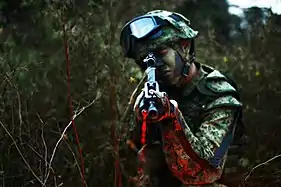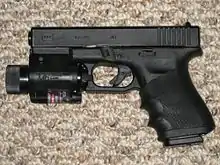Laser sight (firearms)
A laser sight is a device attached or integral to a firearm to aid target acquisition. Unlike optical and iron sights where the user looks through the device to aim at the target, laser sights project a beam onto the target that provides a visual reference point. Although lasers in the visible part of the spectrum are most common, invisible IR lasers may be used in conjunction with a night vision device.[1][2] As they are offset from the barrel, laser sights need to be zeroed in, much like a conventional sight, so that the beam intercepts the point of impact at a chosen distance.[3] Devices may include one or both types of laser, with some models also incorporating a rangefinder, flashlight, or IR illuminator.[4] Laser sights may be attached to the existing sighting mechanism, the trigger guard, via a rail system, or can be integrated into replacement components such as the guide rod or grip plates.[5][6][7] Some variants are also incorporated into other attachments such as foregrips.[8]

Laser sights are primarily used by military and law enforcement, although have some civilian use for hunting and self defence. They are also found on some less lethal weapons, such as Taser electroshock weapons.[9]
Purpose
Accuracy

The use of laser sights is associated with increased accuracy in general, increasing the probability of hitting the target especially in low light conditions.[10][11] The projected dot speeds up target acquisition, decreasing the time required for the shooter to aim and fire, as well as decreasing the time necessary for follow-up shots. Laser sights also aid in point shooting, where the shooter relies on hand eye coordination rather than aiming with a traditional sight.[12] This is of particular use when the user does not have time or is unable to obtain a proper sight picture before firing; for example, the use of ballistic shields or gas masks may obstruct access to the sights. Lasers also increase accuracy when shooting from an unconventional stance.[13]
Training
Laser sights are also a useful training aid. They allow users to practice dry-fire drills while being able to see the point of impact: this has significant safety benefits. Training with laser sights has been shown to improve shooting skills faster, although both instructors and manufacturers recommended that users continue training without lasers to avoid becoming dependent on them.[14][7]
Deescalation
By providing a visual indication of where the gun is aimed, laser sights add an extra factor of intimidation. Studies of law enforcement indicate that suspects faced with laser sights are significantly more likely to surrender, even if they themselves are armed.[15][11]
Use with Night Vision Devices
IR laser sights significantly improve accuracy when using night vision goggles, especially at longer ranges. However, even with laser sights, shot groupings are still inferior to those achieved in daytime, and the degree of improvement is highly dependent on correct set up of the system.[2]
Long range accuracy
Where a laser beam travels in a straight line, the path of a bullet gradually deviates after it leaves the barrel due to external forces such as gravity, wind, and even the rotation of the earth. This a significant issue for long distance shooting; shorter range weapons such as handguns are less affected. Another related issue is that the beam widens over distance, meaning that instead of projecting a small dot, a much larger circle may be produced.[16]
Visibility in bright light
Visibility of laser sights deteriorates in bright light. Green lasers are more effective in bright conditions, however they are more complex to produce so are often larger and more expensive than red lasers.[17]
Aerial targets
Laser sights cannot be used for hunting flying game in the daylight as neither the beam nor dot are visible.[16] A further risk to aircraft is also an issue, as even civilian grade lasers are capable of hitting a plane from 2 miles away.[7]
.jpg.webp)
Batteries
Laser sights rely on batteries to work. As such, they require regular maintenance and may fail during use. Non-water resistant models also risk electrical damage through water ingress.[18]
Added mass
As with all firearms attachments, laser sights add mass to the firearm. This is particularly significant for handguns as many holsters aren't designed to accommodate them.[7]
Risk of eye damage
Lasers can easily cause damage to the eyes. Visible lasers are unlikely to cause permanent damge due to the blink reflex, however IR lasers do not trigger this and thus pose a significant risk.[13]
Revealing position
The use of laser sights poses a risk in tactical scenarios as they may reveal the users location, although this can be mitigated by only turning on the laser when needed.[13] An additional consideration for military and law enforcement is whether the enemy has night vision capabilities; if so IR lasers will be visible to them.[1]
Difficulty zeroing
Laser sights are somewhat more difficult to zero than conventional sighting systems. IR lasers in particular can take in excess of an hour to properly zero, depending on the methods used.[2]
Boresights
Laser boresights differ from laser sights in that they are not intended, or capable, of being used at the same time as the firearm; instead, they are intended to aid in zeroing the firearm. A boresight is a laser in the shape of a cartridge. The user chambers a boresight of the appropriate calibre which projects a laser beam directly down the barrel, providing a visual indicator of the point of impact at a given range. The user then adjusts the sights until they align with the dot. Boresighting suffers from the same weakness as laser sights in that while the beam is straight, the path of the bullet curves; as such it is not a substitute for traditional zeroing, rather they serve to speed up the process.[19]
Law
Restrictions on laser sights vary by jurisdiction. Another consideration is the legality of the laser itself: the power output of military and law enforcement issue devices often exceeds that permitted for civilian use.[1]
U.S.
In the U.S. laser sights are mostly legal for self-defense purposes, however their use for hunting is more strictly regulated.[16]
Users
U.S. police
In a 2019 survey of US police officers, less than 13% used laser sights on duty, with only 32% saying that their agency permitted their use.[22]
References
- Utley, Sean (2020-06-11). "Selecting An IR Laser And Illuminator". Firearms News. Retrieved 2021-01-21.
- Dyer, Smith, & McClure (June 1995). "Shooting with Night Vision Goggles and Aiming Lights" (PDF). U.S. Army Research Institute for the Behavioural and Social Sciences (Report 1678).CS1 maint: multiple names: authors list (link)
- "3 Methods for Zeroing Your Handgun Laser". www.shootingillustrated.com. Retrieved 2021-01-21.
- "StackPath". www.militaryaerospace.com. Retrieved 2021-01-21.
- "What You Need To Know About Laser Sights". www.nrablog.com. Retrieved 2021-01-21.
- McHale, Tom. "A Handgun Laser Primer". blog.beretta.com. Retrieved 2021-01-21.
- Findley, Ben (2013-07-01). "Laser Sights on Firearms: Are they For You?". USA Carry. Retrieved 2021-01-21.
- Fortier, David M. (September 23, 2010). "CGL Foregrip Laser".
- "TASER X2". www.axon.com. Retrieved 2021-01-21.
- McHale, Tom. "Benefits of Using a Handgun Laser". blog.beretta.com. Retrieved 2021-01-21.
- Will Houde-Walter "Violence reduction and assailant control with integral laser-sighted police pistols", Proc. SPIE 2934, Security Systems and Nonlethal Technologies for Law Enforcement, (29 January 1997); https://doi.org/10.1117/12.265415
- Marshall, Brian. "The Case for Laser Sighting". www.policemag.com. Retrieved 2021-01-21.
- Nielsen, Eugene S. "Laser Sights Give You That Tactical Edge". www.policemag.com. Retrieved 2021-01-21.
- "NCJRS Abstract - National Criminal Justice Reference Service". www.ncjrs.gov. Retrieved 2021-01-21.
- "NCJRS Abstract - National Criminal Justice Reference Service". www.ncjrs.gov. Retrieved 2021-01-21.
- Jardim, Frank (February 13, 2019). "How Laser Sights for Hunting Can Improve Your Odds in the Field".
- "Laser Sights: Red vs. Green". www.nrafamily.org. Retrieved 2021-01-21.
- "The Basics of Laser Sights". www.americanrifleman.org. Retrieved 2021-01-21.
- "How Does a Bore Sight Work?". SportsRec. Retrieved 2021-01-21.
- Guide on firearms licensing law (PDF). U.K. Home Office. 2016.
- "Case 236 - Ban on laser sights in rifle range". www.hse.gov.uk. Retrieved 2021-01-21.
- Griffith, David. "Exclusive POLICE Survey: Weapon Lights, Optics, and Lasers". www.policemag.com. Retrieved 2021-01-21.


